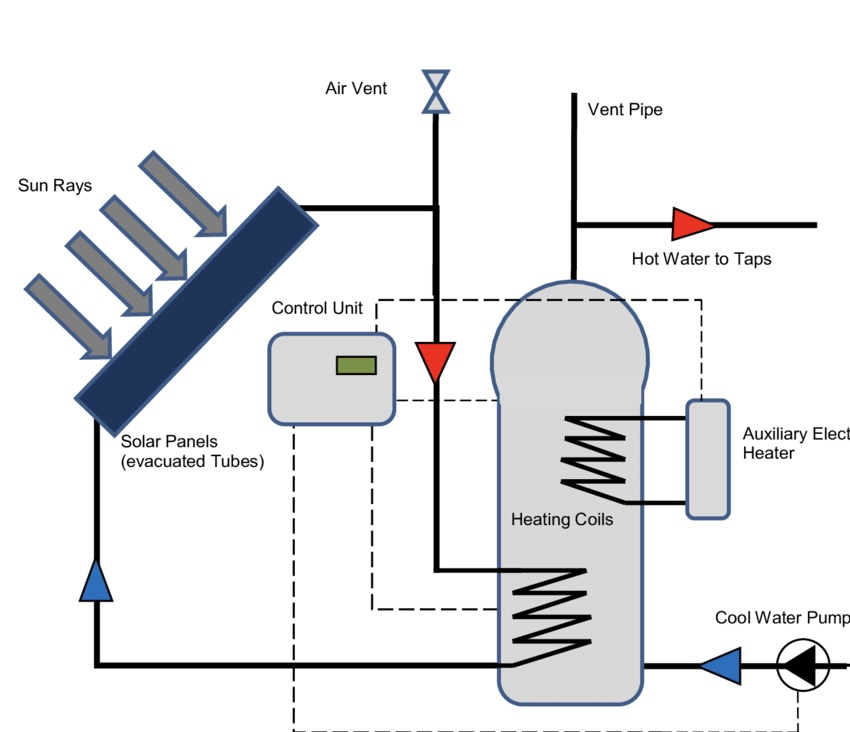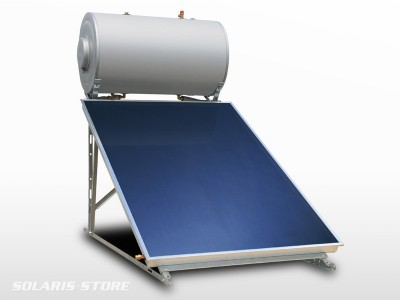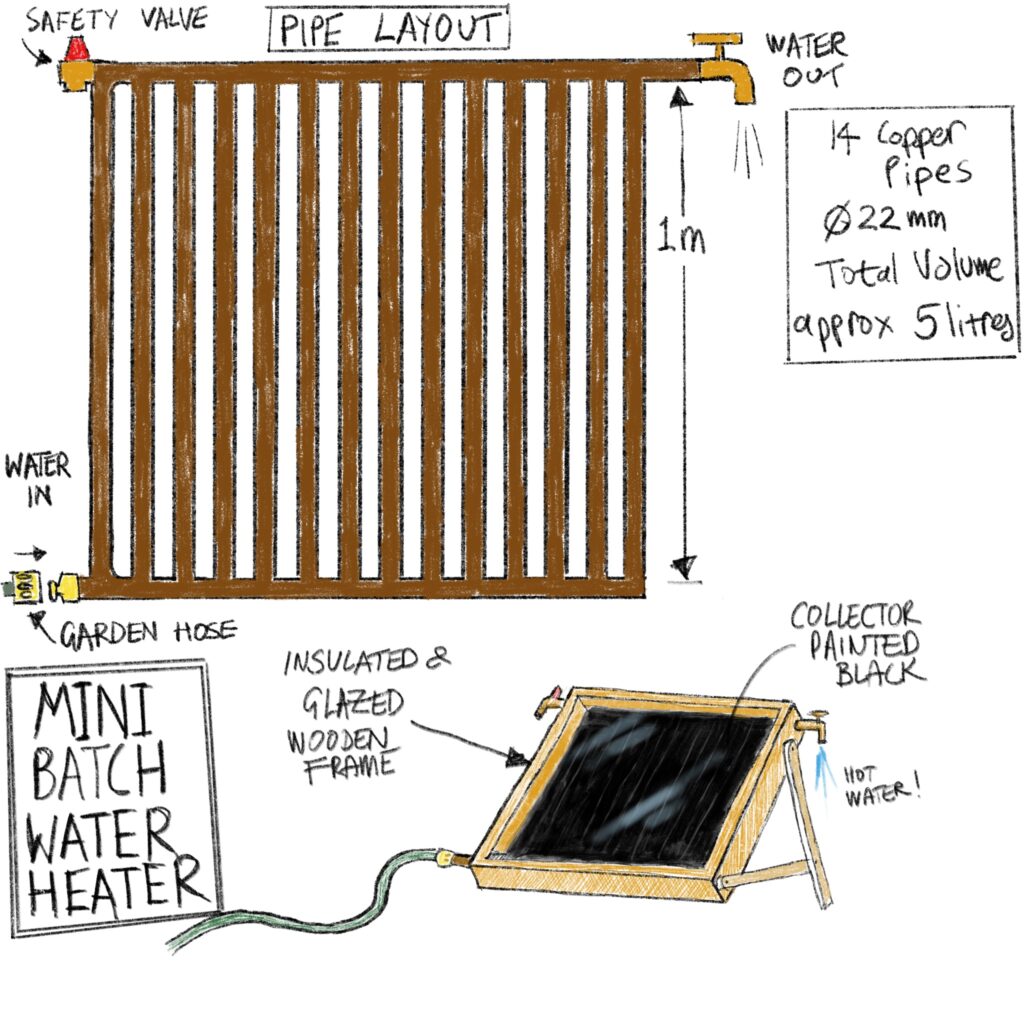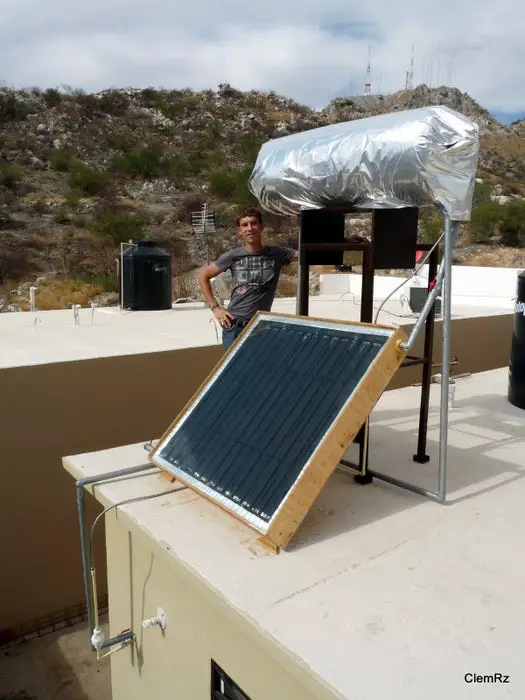In a previous post I dismissed the idea of a solar water heater as being too complicated and expensive.
However, it is still an appealing idea. Simple, clean, free, effective and ideally suited to make use of the sunny French climate where the the tiny house is located.
Unlike a ‘normal’ house with a ‘normal’ family, my hot water requirements are minimal. Using a Portashower, I know I only need 5 litres of water per shower. The tiny house can only sleep three people (and mostly it would be just me). So I could probably get by with 20 litres of hot water per day, or even less.
Commercial Solar Water Heater Systems
The typical solar arrangement (shown below) with a roof mounted solar panel feeding a large hot water cylinder would be way over the top for my tiny house.

Even a simpler ground mounted solar panel with a thermosiphon header tank is too big and too expensive. For example, this 200 litre system, from the French company Solaris, costs nearly 1300 Euros.

DIY Systems
I know that people have been making DIY solar water collectors for years. Typically these consist of copper or plastic pipes in a grid or coil arrangement, painted black and placed in a glazed insulated box. Hot water from these collectors is normally transferred to a tank – either by pump or thermosiphon.
There is plenty of information out there on DIY solar water builds, such as the one shown below from instructables.com.
Going down the DIY panel route has advantages. I could build something small enough to meet my needs and I wouldn’t have to pay the shipping costs of a bulky commercially available panel. But what about the header tank? I don’t need 200 litres. What are the options?
I considered lots of possibilities but the one that seemed most promising was based on an insulated plastic cool box. I could easily get one with about 20 litres capacity (perfect!) and I could probably fit a tap to drain off the hot water as needed. The problem then is that I’d then have to manually top up the panel with cold water, unless I fitted a float valve plumbed to a cold water feed. So even now things are starting to get a little bit more complicated.
Is there an even simpler way?

My thoughts then turned to the old idea of the solar batch water heater. At their simplest, these are basically a “tank in the sun”. Typically they consist of a recycled water cylinder, painted black, put in a glazed and insulated box and plumbed in-line with the domestic water heater. Thus the cylinder is both the solar collector and the storage vessel. The hot water coming from the cylinder, into the domestic water system, may require some ‘topping up’ with heat to get it up to temperature, but useful energy savings can still be made.
OK, so the batch water heaters are cheap and simple, but I dont want a giant cylinder in my garden with much more water than I need.
But what if I could make a normal solar collector with a large enough water capacity that it effectively became a batch heater? I.e. no need for a separate tank.
Remember, I only need 5 litres of hot water at any one time.
With this in mind, I came up with the following design:
Mini Batch Water Heater

There is nothing revolutionary in my design. The important point is that the 22mm copper pipe is large enough to give a total water volume of 5 litres for a panel that is around 1 square metre. It might not heat up as quickly as a normal collector (which has a lower water volume) but that’s not too important. If it can get the water to 45 deg C in 30 mins or so, that will be absolutely fine.
I wont go into too much detail regarding the construction. The 22mm copper pipe would be soldered together using standard elbows and tees. Ideally it would be clipped onto a thin metal sheet of some kind in order to increase the amount of heat absorbed, but I think this is optional. The whole lot is then sprayed matt black.
The retaining frame is made from wood and insulated at the rear to reduce heat loss. I think that anything can be used for the insulator but I suspect a sheet of foam would be cheap, effective and easy to get hold of.
As for the glazing, I wouldn’t be too keen on using real glass. Besides the weight and fragility, it would also have to be custom cut. I would go for clear, corrugated polycarbonate. To avoid it fogging on the inside, I would seal the ends with tape. A bead of clear silicone would fix it into the frame.
A pressure reducing valve (PRV) might be an idea if there was any chance that high temperatures would cause water expansion and pressure on the solder joints. I guess this wouldn’t be needed if the heater was attached to a garden hose as this could expand slightly. Of course, if the garden hose was disconnected all the water would drain out! So maybe a non return valve would be a good idea, in which case the PRV might be needed after all.
Some wooden legs either side of the frame would allow the panel to face the sun at, say, 45 degrees. If I was being really clever I could make a cradle so that the panel could be rotated to any angle.
If I wanted to store a greater quantity of hot water then I could fill up an insulated container 3 or 4 times during the afternoon, giving me some for the evening.
Should the panel prove to be effective, it might actually be worth connecting it to the water system of the tiny house. It could conceivably be fixed onto one of the exterior walls of the house and hinged so it would swing outwards to collect the sun.
To conclude – solar is back! If I make it to France this summer (2021) and I finish all the other jobs I have to do, then I will have a go at making the mini batch water heater. Stay tuned to see if it works…



I appreciate your clear explanations and the emphasis on safety throughout the process.
It’s evident that you care about your readers’ well-being and want us to tackle these issues safely and effectively.
Your blog has become my go-to resource for appliance-related issues,
and I’ll be sure to share it with friends and family who might face similar problems with their appliances.
Keep up the fantastic work!
Thanks for your kind words. The blog has taken a back seat due to many other changes in my life, such as moving house. I will (eventually) get back to it as I want to update the posts and write some new ones. But I’m glad my old posts have been helpful.